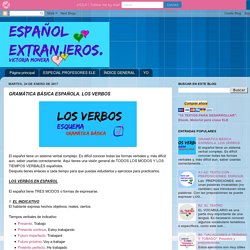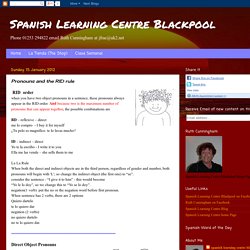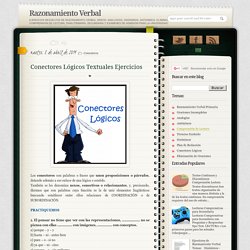

A2-B1. USOS DE SER Y ESTAR. ¿VAMOS A LA PLAYA? Practiquemos las preposiciones. Test de gramática española. [x] Cerrar.

ESPAÑOL EXTRANJEROS. Victoria Monera.: GRAMÁTICA BÁSICA ESPAÑOLA. LOS VERBOS. El español tiene un sistema verbal complejo.

Es difícil conocer todas las formas verbales y, más difícil aun, saber usarlas correctamente. Aquí tienes una visión general de TODOS LOS MODOS Y LOS TIEMPOS VERBALES españoles. Después tienes enlaces a cada tiempo para que puedas estudiarlos y ejercicios para practicarlos. LOS VERBOS EN ESPAÑOLEl español tiene TRES MODOS o formas de expresarse. El hablante expresa hechos objetivos, reales, ciertos. Tiempos verbales de indicativo Se expresa lo subjetivo: los sentimientos, las dudas, la posibilidad. Ejercicios para aprender español. Ejercicios de gramática . Spanish exercises. ESPAÑOL EXTRANJEROS. Victoria Monera.: B1-B2. PREPOSICIONES. "LUIS" Las preposiciones. Corrección ortográfica, gramatical y de estilo interactiva.
2000+ Hojas de trabajo de ELE gratuitas hechas por unos profesores de idioma para otros. Ser vs. Estar - Which one do we use? Indicativo vs Subjuntivo: 100 frases donde elegir. Spanish Learning Centre Blackpool: Pronouns and the RID rule. RID order when you have two object pronouns in a sentence, these pronouns always appear in the RID order.

Andbecause two is the maximum number of pronouns that can appear together, the possible combinations are RD – reflexive – direct me lo compro - I buy it for myself ¿Tu pelo es magnifico. te lo lavas mucho? ID – indirect – direct Yo te la escribo - I write it to you Ella me las vende – she sells them to me La La Rule When both the direct and indirect objects are in the third person, regardless of gender and number, both pronouns will begin with 'L'; so change the indirect object (the first one) to “se”. consider the sentence - “I give it to him” - this would become “Yo le lo doy”, so we change this to “Yo se lo doy”. negation(1 verb) put the no or the negation word before first pronoun.
When sentence has 2 verbs, there are 2 options Quiero dartelo te lo quiero dar negation (2 verbs) no quiero dartelo no te lo quiero dar. Good video in Spanish/English describing uses of imperfect vs. preterite with lots of examples. Language Links 2006 - Preterite vs. Imperfect. Post information, handouts, and activities for helping students learn to distinguish between the preterit and the imperfect tenses in Spanish on this page.

Ideas contributed to FLTeach- CarrieEGoldPret vs Imp Packet.doc- Shows rules of choosing between preterit and imperfect, as well as provides practice for choosing between the two tenses. There are also lyrics for JLo's "Que Hiciste" and a project outline based on one found on this wiki. Preterite-Imperfect Formulas. Ejercicios: Pretérito e imperfecto. Pretérito e imperfecto Respuestas Visita a España.

Position of objects in Spanish. Cuando era pequeña. Pretérito Imperfecto. A2. Indirect object pronouns (me, te, le, nos, os, les) Overview Indirect objects tell “to whom” or “for whom” something is done.

Just like direct object pronouns replace direct objects, indirect object pronouns are the replacements for indirect objects, which are always personal nouns. Below you can find the chart which separates the indirect object pronouns into 1st, 2nd, and 3rd person as well as singular or plural. Notice that the English definition for each indirect object includes "to/for" since they always indicate where the object is going. Notice that the 1st and 2nd person pronouns are the same as the direct object pronouns and that the 3rd person pronouns, "le" and "les" do not indicate any gender.
Spanish Grammar. 20 maneras de expresar probabilidad. Ejercicios para aprender español. Ejercicios de gramática . Spanish exercises. Varios. Spanish Language Exercises - Instructor-Check - Verbs. In this section you will find categories for instructors-check exercises covering different aspects of the Spanish verbs.

Choose from the index on the left to access the exercises. When you click on the exercise a new browser window will open. To return to this page after doing the exercise close its window click on the top right corner in a PC, and on the top left corner in a Mac). Future and Conditional Student has to choose between these two tenses from 6 pull down menus in a short story. 3 additional questions and 1 external link relate to the Alhambra. Imperative I (Tú) 15 blanks in a dialogue to use the informal commands. Imperative II (Usted) 4 sets of blanks to give affirmative and negative formal commands according to the icons provided. Imperfect Indicative Provided model with usage of the Imperfect in relation to childhood events. Imperfect/Preterit Indicative I. Spanish Index. Conectores Lógicos Textuales Ejercicios. Los conectores son palabras o frases que unen proposiciones o párrafos, dotando además a ese enlace de una lógica o sentido.

También se les denomina nexos, conectivos o relacionantes, y, precisando, diremos que son palabras cuya función es la de unir elementos lingüísticos buscando establecer entre ellos relaciones de COORDINACIÓN o de SUBORDINACIÓN. EL PRESENTE. ¿Qué hace Marta cada día? – Divinas Palabras. Victoria Monera. EL PRESENTE es el tiempo verbal que usamos para expresar lo que hacemos cada día, en nuestra vida habitual.

Con este ejercicio vamos a aprender el presente y vamos a practicar el vocabulario “ACCIONES DIARIAS“. Tienes que leer con atención las frases y después ordenarlas cronológicamente. Presente irregular (1): Cambio vocálico y totales. Después de ver el presente regular, en este vídeo vas a aprender algunas formas del verbo presente irregular en español: los irregulares totales y los verbos con cambio vocálico.

Mira el vídeo y después completa las actividades. Irregulares totales SER, IR y ESTAR. Recursos para enseñar el Pretérito Indefinido. ESPAÑOL EXTRANJEROS. Victoria Monera.: A1. TEXTO CON PREPOSICIONES. "ROBERTO" Las PREPOSICIONES son unas palabras invariables (no cambian) que introducen otras palabras. Con las preposiciones se puede expresar LUGAR, DIRECCIÓN, TIEMPO, ORIGEN, FINALIDAD...
Suelen ser difíciles para los estudiantes de ELE y lo mejor para aprenderlas bien es practicar mucho. Aquí tienes un texto con huecos para completar con preposiciones (y las respuestas abajo en "Más información" para que te auto-corrijas). Puedes mirar CON P DE PREPOSICIÓNROBERTORoberto es un famoso cocinero (1)……….Alicante. Está casado (2)……..Rosa, mi profesora (3)………historia del arte. Yo he hablado muchas veces (14)…………ella y me ha dicho que prefiere vivir (15)……….Alicante centro porque hay muchas más ofertas culturales: cines, teatros, museos, etc.
Ahora hablaré (19)……….mi familia. Mi madre, Anabel, es ama (24)……….casa. Expresar-la-probabilidad.